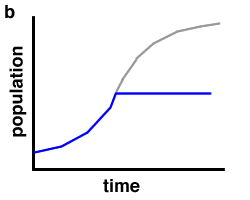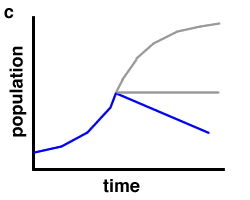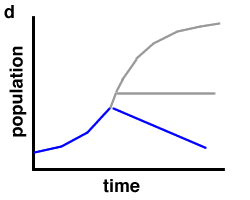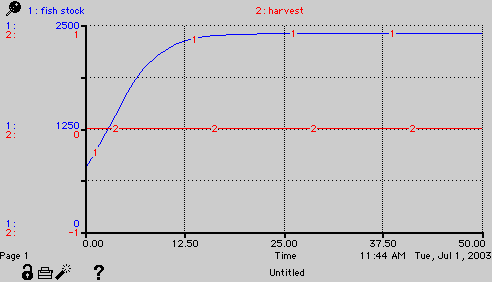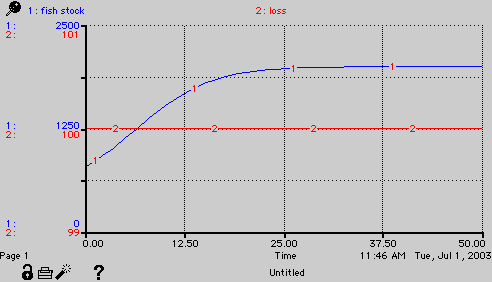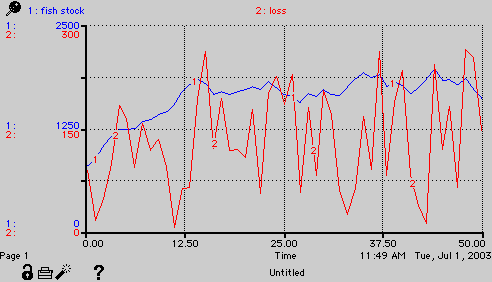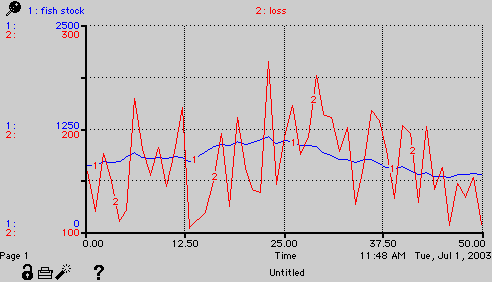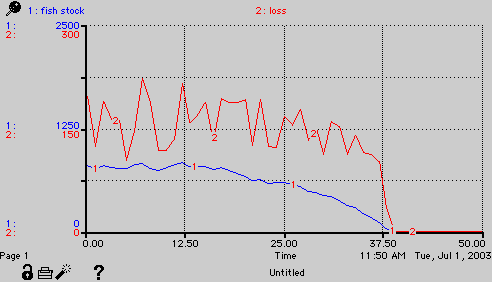
Title: Fisheries as a common resource
Introduction
Fisheries in the open ocean are just one example of a common pool resource that can be exploited by anyone and is sensitive to over exploitation. Common pool resources are resources that have high subtractability (any use subtracts the resource from any other use) and where exclusion from the resource is difficult (anyone can gain entry). There are other classifications of resources that would have different problems and appropriate solutions.
Table 1: Resource classification by subtractability and exclusion. Subtractability means that a use of one unit of the resource removes that unit from anyone else's use. Exclusion is whether it is easy to limit access or impossible.
low
subtractabilityhigh
subtractabilitydifficult
exclusion
goodscommon pool
resourceseasy
exclusion
goods
goods
Maximum sustainable yield and over harvest. The amount of fish that is taken in any season is the "yield". Ecosystem managers calculate the maximum sustainable yield as the maximum value of the population times the growth rate. At low population size the yield is limited by the number of reproducing fish. At high populations the yield is limited by the decrease in the growth rate from inter- and intra-specific competition for resources. The maximum sustainable yield is the theoretical maximum point that is half of the carrying capacity. Over harvest can happen in two ways, either the maximum yield is an overestimate or a correct MSY could be taken too early when the population is still too small. Over harvest decreases that population such that the growth for the next season will be decreased. Thus Over harvest and early-harvest are related processes.
Figure 1. a- Theoretical optimal sustainable yield for a population going through a logistic growth transition. Early in the growth phase, the population growth is controlled by rapid growth rate and the number of fish. Later, the population growth (yield) is dominated the decrease in the intrinsic growth rate as the population reaches the carrying capacity. In the middle of the curve, the highest slope, is the population value that will give the highest yield. b - when the maximum sustainable yield is initiated just as the population gets to the midpoint, the population will stay constant. c- If the harvest is higher than the maximum sustainable yield, the population will decrease. d- Applying the maximum harvesting rate before the population has reached the mid-point will also result in a decrease in the population.
Logistic growth curve
Maximum harvest at the midpoint is sustainable
Over harvest at the midpoint leads to decline
Maximum harvest, but early, leads to decline
This theoretical maximum yield should be reduced for several reasons. The process of harvesting can degrade the conditions necessary for optimal growth. Too many roads in the forest, catching too many non-target fish or trampling of a pasture are examples of this type of damage. It reduces the ability of the environment to grow the resource without directly showing up in the harvest. Natural variability in the conditions should also be accounted for in calculating the actually yield that can be tolerated. Variations in weather or other populations in the ecosystem can result in good and bad seasons for growth. Maximal harvesting during a bad year can decrease the population below the sustainable level. Often the variability is a source of uncertainty for ecosystem managers. Still, they need to be able to make decisions to set a harvest rate and to be take precautions against the collapse of the fishery.
Variability in fishery production. Even healthy natural environments undergo swings in the overall productivity and especially the growth of one species in the food web. Understanding that this variability was a key component of our attempt to understand food webs using a network view.The degree of variability can be quite large and the system can stay healthy. However, with artificially harvest superimposed on top of natural variability, the results can be disastrous. The following simulations (Figure 2) demonstrate the effects of a population that is either fished, or perturbed by a density dependent loss, or both. Each simulation run represents one possible trajectory through time, with random events. There is a range of outcomes, and each can be predicted roughly from the probability of the loss (Figure 3). Given the dynamic nature of natural ecosystems, it may not be possible to determine the probability of loss to any degree of certainty, i.e. the loss may be uncertain no matter how much this population were studied.
Figure 2. Simulation results for a fish stock that is growing with and with harvest and stochastic loss terms. The parameters for all models are r=.3, K=2400, initial population =800. The population is controlled by the logistic equation. The stochastic loss is a random percent loss (up to the maximum of a 10% loss) times the population. a- growth with no fishing. b - growth with a harvest of 100. c. stochastic loss only. d- harvest and up to a 10% stochastic loss combined.
fig2a - no harvest
fig2b - harvest rate of 100
fig2c - on example run with a stochastic loss of up to 10% of the population per time
fig2d - one example run with both a constant harvest of 100 and a stochastic loss of up to 10% of the population per time.
Figure 3. With any stochastic loss there are multiple trajectories for the population. a - one selected output that shows a collapse of the population. b - another selected output that shows increase in the population over the period shown
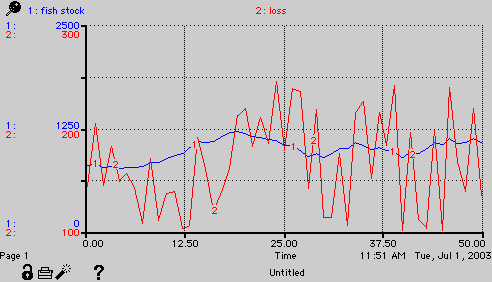
There are many ways to cause extinction. Just as it was claimed that "all roads lead to Rome", it seems that for our current civilization, all roads lie perilously close to causing extinction and collapse of our natural resources. Our choice to exploit natural resources must be accompanied with taking responsibility for our actions and the consequences for the environment.
We face two fundamental decisions when we use of natural resources. If the resource is a "common pool resource", we have to decide how we will adjust our use to that of other users. How will we know if we are overexploiting the resource? The second question we face is how to deal with the uncertainty in the system and to abide by the "precautionary principle" which states that in the face of uncertainty, choose the path that will do the least damage
In this case study and accompanying framework discussion, we will explore how to structure these decisions as game, either a game against other possible users of the resource or as a game against nature to deal with uncertainty.
Resources
You should read the above case study.
Then read the general treatment of a game.
Then return to work through the practice application below.
This should prepare you to do the application assignment in class.
References
this will be filled in later

